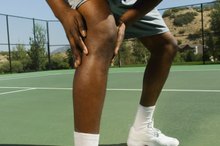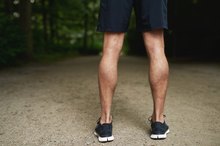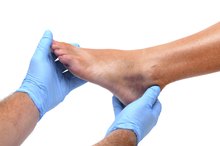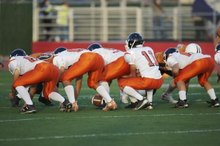Does Jogging Help Strengthen the MCL?
The medial collateral ligament, or MCL, connects your thigh and shin bones along the inside of your knee. The MCL is susceptible to injury, usually from a powerful blow to the opposite side of the knee. Although certain types of exercise may reduce the likelihood of an MCL sprain and aid in recovery after such an injury, jogging is not typically recommended as a way to strengthen the MCL.
Injuries
The MCL is rope-like structure composed of relatively inelastic collagen fibers. Injuries occur when forces stretch the MCL beyond its limited flexibility and the collagen fibers tear. This injury, called an MCL sprain, can range from mild to severe, depending on the degree of tearing. There is little you can do in terms of exercise to prevent an MCL injury because it does not occur due to ligament weakness, but rather, because a forceful blow damages the knee. Although MCL sprains usually heal without surgery, the recovery process typically lasts weeks to months, depending on the extent of tearing.
Early Healing
Vastus Lateralis & Muscle Strain
Learn More
Recovery from an MCL sprain occurs in stages. The knee is often protected by a brace early in the healing process to prevent side-to-side movement of the joint while repair of the torn fibers commences. With moderate to severe tears, crutches may be needed to prevent weight bearing on the injured knee. As knee pain and swelling subside, weight bearing is gradually resumed. As healing progresses, the torn tissue mends as new collagen fibers form. Although most MCL tears eventually heal, the ligament typically remains weaker than it was prior to the injury, making it vulnerable to further damage.
Rehabilitation
After the initial phase of recovery from an MCL injury, the focus changes to reestablishment of knee range of motion and gradual reintroduction of exercise. Rehabilitation after an MCL injury is conducted under the care of a physician in collaboration with a physical therapist to ensure that the process does not progress too quickly, resulting in reinjury of the ligament. Pedaling on a stationary bicycle is a common form of exercise during MCL rehabilitation. Strengthening exercises for the hamstrings and quadriceps help stabilize the injured joint. Exercise also helps the MCL itself heal by encouraging the proper formation and alignment of new collagen fibers. As rehabilitation progresses, weight training becomes part of the physical therapy regimen.
Jogging
Knee Pain in the Medial Collateral Ligament When Running
Learn More
Resumption of jogging after an MCL injury occurs gradually; returning to jogging too soon after an MCL injury may lead to another tear and a protracted recovery. The process begins with brisk walking every other day, building to a mile distance. If no pain or swelling occurs, jogging replaces walking for increasingly greater distances until the goal distance is accomplished. Many doctors recommend wearing a knee brace for several months after completion of rehabilitation to support the MCL during strenuous activities.
Related Articles
References
- American Academy of Orthopaedic Surgeons: Collateral Ligament Injuries
- Massachusetts General Hospital: Rehabilitation After Injury to the Medial Collateral Ligament of the Knee
- University of Utah Musculoskeletal Research Laboratories: Ligament Injury and Healing
- Kaiser Permanente: Strengthening and Stability Exercises for Your Hips, Knees and Ankles in Standing
- Concepts of Athletic Training; Ronald P. Pfeiffer and Brent C. Mangus
- Massachusetts General Hospital: Return to Running Program
Resources
Writer Bio
Dr. Tina M. St. John owns and operates a health communications and consulting firm. She is also an accomplished medical writer and editor, and was formerly a senior medical officer with the U.S. Centers for Disease Control and Prevention. St. John holds an M.D. from Emory University School of Medicine.









